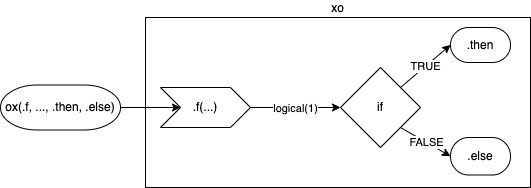
ox short hand if-else.
Symbolically, letter “O” and letter “X” represents opposite
characteristics. Usually, “O” is associated with acceptance while “X”
symbolizes rejection. This summarizes the meaning of the ox
which manages switching two values based on the TRUE/FALSE
condition.
Reason to create this package is to simplify the code to check and
replace the object if it does not satisfy given assumptions. Following
code illustrates typical situation when x is checked
(possibly against y) to return x or
y.
# basic syntax
if (is.fun(x)) x else y
if (fun(x, y, ...)) x else yox package offers a different syntax for above base R
calls, where x and y can be used once in the
call to produce the same output.
ox(fun, x, .else = y)
ox(fun, x, y)ox syntaxox has four arguments:
.f a function which returns a single logical
value.... named or unnamed arguments to be passed to
.f(...) to evaluate..then is a positive-replacement, returned when
.f returns TRUE. By default, it’s the first
argument from .....elselse is a negative-replacement, returned when
.f returns FALSE. By default, it’s the last
argument from ....
Consider simple where x checked if it’s a character. If
condition is TRUE ox returns x
(.then) otherwise .else. Since
.then has not been specified directly
object = x is considered as a default value to return when
.f returns TRUE. In this example
x is a argument of .f and is returned as
.then in the same time.
x <- "a"
y <- "b"
ox(.f = is, object = x, class2 = "character", .else = "b")
# [1] "a"Another example illustrates the comparison between two values and
return one matching the condition. In this case y is
greater than x so it’s returned. Both x and
y are used in the function and returned as
.then and .else in the same time.
x <- 1
y <- 2
ox(`>`, x, y)
# [1] 2Syntax is also optimized to use pipe operators. For
magrittr::%>% it’s very convenient as one can use
.. With |> one needs to specify
.f = <fun> and x will go to the
ox as first argument.
library(magrittr)
x <- 4
x %>% ox(.f = `>`, 5)
# [1] 5
x %>% ox(`>`, ., 5)
# [1] 5
x |> ox(.f = `>`, 5)
# [1] 5OX
ox version for switching vector values instead of
switching single-objects one can use OX. OX
replaces values of the .then with values of
.else when condition is FALSE.
.else should be a atomic or a
list. Function .f in OX can
return logical vector or integer which
determines indices of .then to be kept or replaced.
.then with single valueWhen .else is a vector, the values of .then
are replaced by the values of .else on the same indices -
.then[!idx] <- .else[!idx]
# pick larger values from two vectors
OX(`>`, c(1, 2, 3), c(3, 2, 1))
# [1] 3 2 3When .else is a single value, the values of
.then are replaced by this value -
.then[!idx] <- .else
x <- c(NA, 1, NA)
OX(Negate(is.na), x, .else = 2)
# [1] 2 1 2When .else is NULL, the values of .then are
dropped from the object - .then <- .then[idx]
# drop values from `.then` is `FALSE`
OX(`>`, c(-1, 0, 1), 0, .else = NULL)
# [1] 1Both functions ox and OX have it’s opposite
versions - xo and XO, which are switching the
result of the condition.
identical(
ox(Negate(is.na), NA, .else = 1)
xo(is.na, NA, .else = 1)
)
# [1] TRUE
xo(is.na, NA, .else = 1)
# [1] 1
XO(is.na, c(NA, NA, 2), .else = 1)
# [1] 1 1 2